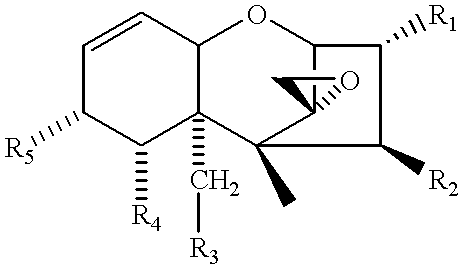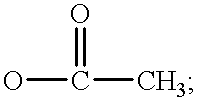Compositions and methods for epidermal chemexfoliation
a technology of chemexfoliation and compositions, applied in the direction of biocide, plant/algae/fungi/lichens, drug compositions, etc., can solve the problems of naoh destroying toxic activity, avoiding trichothecene, and low tumor respons
- Summary
- Abstract
- Description
- Claims
- Application Information
AI Technical Summary
Benefits of technology
Problems solved by technology
Method used
Image
Examples
example 1
A patient presents with a wart on the back of their hand that they want removed. The wart is rounded with a base diameter of 5 mm an 3 mm high at the peak (note: the size of the wart is immaterial under method 2). Treatment: The 1% worst case blood NTC level is chosen, indicating a 500 ng macrocyclic dose to be administered, and a 5000 ng / ml solution of roridin in ethanol is used. The patient's hand is placed flat on a table with the wart pointing up. The wart is defatted with acetone. Petroleum jelly is applied around the wart to form a crater with the wart in the center of the crater. 0.1 ml of solution is applied into the crater by eve dropper, over a period of time to allow the dose to absorbed into the skin and ethanol to evaporate. Air flow and or heated air flow may be used to expedite the process.
example 2
A patient presents with a wart on the back of their hand that they want removed. The wart is rounded with a base diameter of 5 mm an 3 mm high at the peak. Treatment: The 1% worst case blood NTC level is chosen, and a 100,000 ng / ml solution of T-2 is used to deliver the 10,000 ng dose. The patient's hand is placed flat on a table with the wart pointing up. The wart is defatted with acetone. Petroleum jelly is applied around the wart to form a crater with the wart in the center of the crater. 0.1 ml of solution is applied into the crater by eve dropper, over a period of time to allow the dose to absorbed into the skin and ethanol to evaporate. Air flow and or heated air flow may be used to expedite the process.
example 3
A patient presents with a wart on the back of their hand that they want removed. The wart is rounded with a base diameter of 5 mm an 3 mm high at the peak. Treatment: The 1% worst case blood NTC level is chosen, and a 100,000 ng / ml solution of T-2 in ethanol is used to deliver a 5,000 ng dose of T-2 and a 5,000 ng / ml solution of satratoxin in ethanol is used to deliver a 250 ng dose of satratoxin. The patient's hand is placed flat on a table with the wart pointing up. The wart is defatted with acetone. Petroleum jelly is applied around the wart to form a crater with the wart in the center of the crater. 0.05 ml of the T-2 solution and 0.05 ml satratoxin solution is applied into the crater by eve dropper over a period of time to allow the dose to absorbed into the skin and ethanol to evaporate. Air flow and or heated air flow may be used to expedite the process.
PUM
| Property | Measurement | Unit |
|---|---|---|
| Length | aaaaa | aaaaa |
| Length | aaaaa | aaaaa |
| Length | aaaaa | aaaaa |
Abstract
Description
Claims
Application Information
 Login to View More
Login to View More - R&D
- Intellectual Property
- Life Sciences
- Materials
- Tech Scout
- Unparalleled Data Quality
- Higher Quality Content
- 60% Fewer Hallucinations
Browse by: Latest US Patents, China's latest patents, Technical Efficacy Thesaurus, Application Domain, Technology Topic, Popular Technical Reports.
© 2025 PatSnap. All rights reserved.Legal|Privacy policy|Modern Slavery Act Transparency Statement|Sitemap|About US| Contact US: help@patsnap.com



